| 1 | Inland taipan |
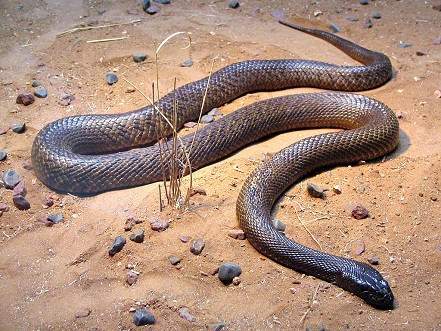
Maximum length: at least 250cm.
The most toxic snake venom on Planet Earth, among over 3800 species. Inland taipan venom has a muscle-melting, skin-shredding LD50 score of 0.025mg, versus 0.9mg for a king cobra. The venom consists of neurotoxins which trigger paralysis, fainting, and ultimately respiratory failure. It’s also rapid-acting, able to disable a rodent prey within minutes.
However, being the undisputed king of toxicity, the inland taipan seems to have decided that it doesn’t need to prove itself, and has retreated to the desert. Inland taipans live in cosy clay cracks, and rarely emerge from them. They eat and sleep in these cracks, cornering their rodent prey in dark passages. They occasionally slither out and visit a shallow river bordered by eucalpytus trees, but even outback dwellers rarely encounter this snake. Consequently, the inland taipan has never caused a human death on record.
Approximately 90% of inland taipan bites result in envenomation. The venom yield is also decent, at 44-110mg. Specific toxins include oxylepitoxin-1, alpha-oxytoxin 1, and alpha-scutoxin 1, and the first symptoms appear in 45 minutes.
| 2 | Stephen’s banded snake |
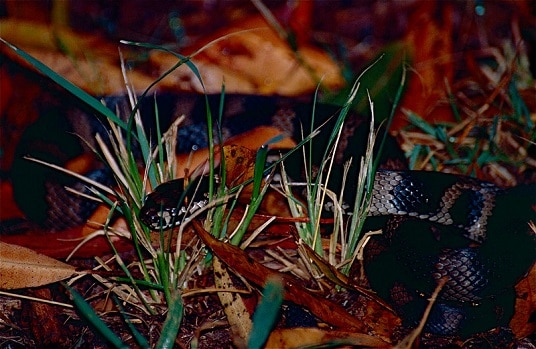
Maximum length: 120cm.
This venomous snake has the ability to fall from the sky and land on your head. Stephen’s banded snakes inhabit Australia’s east coast. Not only are they a tree snake, but they rest extremely high in trees, up to 20 metres above ground. Tree trunks with many hollows and chambers are their favourite. Despite resting all day, this snake is nervous and turns vicious when people enter its domain.
Its venom matches its temperament, as Stephen’s banded snake produces a haemotoxic elixir which increases blood clotting via altering prothrombin. Paradoxically, this increases bleeding, as the blocked blood vessels burst, and blood pours from the victim’s eyes and open wounds.
One death has been recorded from this snake, a 60 year old man from Kalang. This coincided with the 2013 New South Wales floods, and the man didn’t receive antivenin for 7 hours, as the emergency services were unable to reach him. An additional death factor is that they have supreme camouflage; you might not notice the horror disguised against a tree trunk.
No antivenin is available for Stephen’s banded snake yet. 4 doses of tiger snake has been found to work, but if you look up and see one falling, it’s wisest to run to the safety of your car.
| 3 | Red-bellied black snake |
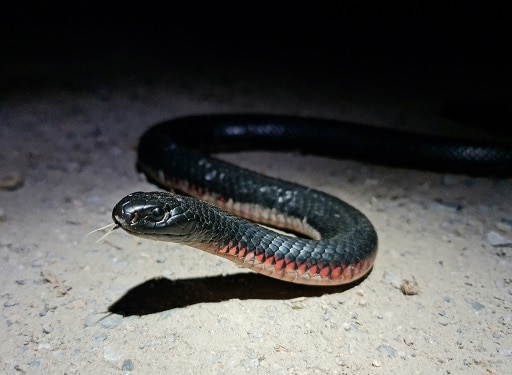
Maximum length: 255cm.
According to a survey from 2005 to 2015, the red-bellied black snake is responsible for 16% of Australian snakebites. This species rarely kills anyone, and the venom’s LD50 score is a comparatively weak 2.45mg. However, they make up for it with their hyperactivity. This snake is always on the move, even in winter when other snakes are in motionless torpor; females can travel over 1km in 24 hours.
Red-bellies are always investigating burrows for prey, or going on adventures into ponds to search for fish. Consequently, this snake is often encountered by ordinary east coast Australians, and that’s why it bites so many people. Red-bellied black snake venom has strong anticoagulant properties, causing spontaneous bleeding. It contains the unique pseudexin, comprising 25% of the venom, and a neurotoxin called a-elapitoxin Ppr1.
Red-belly bites are agonisingly painful, causing swelling, rotting flesh and redness. One of the freakiest symptoms is red-brown urine, due to myoglobin being released from assaulted muscle tissue. However, you have a good chance of winning the snake roulette with this species, as only 70% of bites resulted in systemic envenomation in one study.
| 4 | Mulga |
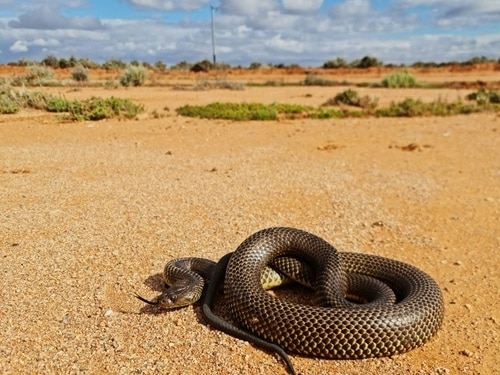
Maximum length: 330cm (Australia’s longest venomous snake).
The most thuglike of Australia’s venomous snakes. The venom isn’t the strongest, but mulgas are violent and will hiss loudly at anyone nearby. They’ll never back and down and flee, and if the encroacher doesn’t get the message and turn around, they won’t hesitate to bite repeatedly, sometimes gripping the victim’s arm and chewing.
Mulga snakes occupy over 90% of Australia, and are the country’s longest venomous snake. They average at 2 metres, and the longest ever reached 3.3 metres. They often sneak into people’s bedrooms at night and bite them, and their dietary preferences don’t exist: mulga snakes will eat anything, including other snakes.
The venom’s LD50 rating is 1.91mg, and the last officially recorded death was in 1969 when a man reached under a wooden verandah in the wheat town of Three Springs. However, the venom yield is colossal. The norm is 150mg, but over 1000mg isn’t exceptional. Mulga snake venom causes nausea, vomiting, abdominal pain, headaches, diarrhoea, and also visual changes. Don’t mess with this snake, because you won’t win. Mulga snakes are also known for brutal wrestling bouts with rival males of their species.
| 5 | Lowlands copperhead |
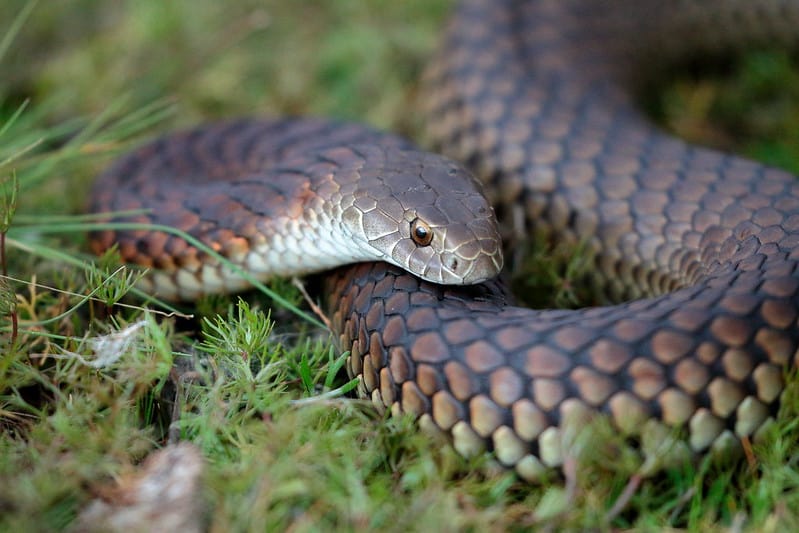
Maximum length: 183cm.
The Australian copperhead, not to be confused with the US terror of Louisiana. This venomous snake is notable for coping extremely well with human habitats. When agriculture arrives and decimates the natural world, the lowland copperhead stays put. It can inhabit areas dominated by intensive agriculture for 100 years, and during winter, it can hibernate beneath roofing iron, tractor tires, and haybales. When active, it often lives in manmade drainage ditches.
Consequently, ordinary Australians may encounter this species a lot, in the southern Australian coast where it roams. The venom LD50 rating is a mere 2mg, but the yield can be high. The venom is loaded with neurotoxins, cytotoxins, and haemotoxins, the full arsenal.
Generally, lowland copperheads try to escape, and aren’t particularly aggressive, but they’ll bite if you force their hand. They’ll usually begin by flattening their body and thrashing around while hissing. You can recognise the copperhead by its copper colour, although they can be confused with brown snakes. A 2017 study discussed a bite in a dog; it suffered almost complete paralysis, including respiratory paralysis, and was miraculously saved with antivenin.
| 6 | Common death adder |
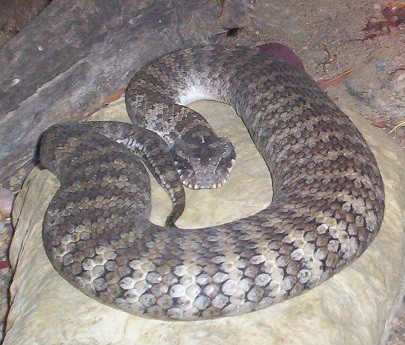
Maximum length: 100cm.
This venomous snake is deadly, but so relaxed that you’ll probably walk past and get away with it (don’t let your guard down though). Common death adders are 40-80cm long, but with an extremely thick body. They’re native to eastern Australia and the far southern coast. The LD50 is stronger than red-bellies and mulgas at 0.6mg, and the venom yield is also high at 70-236mg. This is a neurotoxic snake. If injected via its needle-like fangs, the venom causes speech, breathing and blinking problems, followed by the final symptom: lung failure. Before antivenin arrived in the 1950s, 50-60% of death adder bites were fatal.
If this was a hyperactive snake, it could be Australia’s deadliest. But the death adder is an ambush snake, and the most common spot to find them is resting motionless in forest trails, sometimes popular dog-walking paths. Common death adders can lie motionless for weeks, and go without food for longer. They wait and wait for a lizard to tiptoe past, and suddenly activate, lunging forward brutishly. As a 1.7 metre human won’t activate this hunting instinct, the main worry is stepping on them. No deaths have happened this century, although the northern and desert death adders dealt out one death each in the 1990s.
| 7 | Rough-scaled snake |
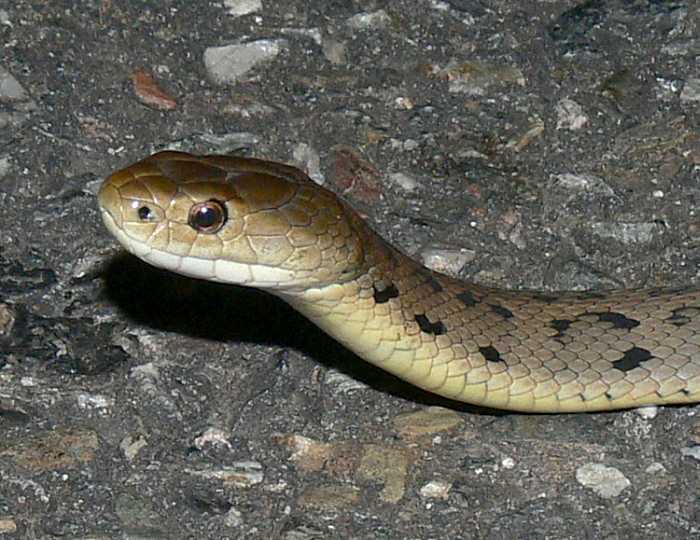
Maximum length: 100cm.
This venomous snake is the only member of the Tropidechis family. The rough-scaled snake lives in eastern Australia, including the outskirts of Brisbane. It has a particularly loud and explosive hiss, which it uses as a warning. Rough-scaled snakes are shy and nervous, and coil into an s-shape when threatened. They often pounce and bite before making an attempt to escape.
Rough-scaled snakes have some neurotoxic qualities, but they mainly specialise in bleeding. In a study on 24 bite victims, only 2 experienced neurotoxic symptoms. However, 10 had traces of blood in urine, and one had a major intra-abdominal haemorrhage. Mild symptoms like nausea and headaches were experienced by 17 people. Some people survive easily with antivenin, but one death is on record, and this person died within 5 minutes.
This snake is often confused with the common keelback, a harmless water dweller with similar colouring. The top locations for bites are south-eastern Queensland and northern New South Wales. Rough scaled snakes aren’t tree dwellers, but will sometimes ascend 5 metres up branches in the course of hunting. They’re most often sighted crossing roads.
| 8 | Eastern brown snake |
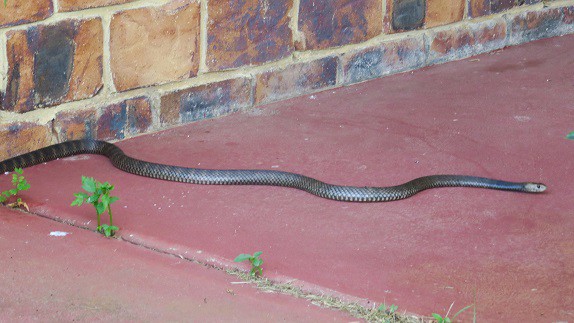
Maximum length: 240cm.
The eastern brown snake has the 2nd most toxic venom of any land snake, behind the inland taipan (several sea snakes are worse). From 2005 to 2015, the brown snake family caused 15 of 19 snakebite deaths in Australia, and 2011 saw 3 deaths from the eastern brown snake itself.
This snake causes very few local symptoms like necrosis, swelling, and blistering. Instead, the venom saves its powers for the inside, triggering nausea, then severe haemorrhaging. The cause of death is usually kidney failure.
Eastern brown snakes are common, and are often encountered by front doors, on pavements, or on bush trails by explorers wearing backpacks. They’re not especially aggressive, but nor are they cowardly. If this video is to be believed, they’re activated by movement. Stay still, and they’ll calm down and start leaving, but move a muscle, and the hiss will sound and the snake will spin right back into its aggressive posture.
Eastern brown snakes are only redeemed by their tiny venom yield, at just 4-10mg, although that’s more than enough to wipe people out. Additionally, the antivenin is stocked in almost all Australian hospitals.
| 9 | Small eyed snake |
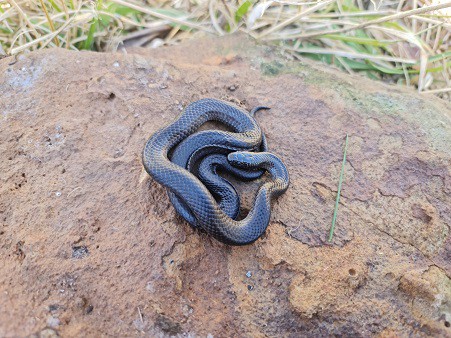
Maximum length: 120cm.
This venomous snake doesn’t have exceptionally small eyes, but it does have a bright pink belly, or occasionally cream, which contrasts against its black scales. Small-eyed snake venom is especially mytotoxic, meaning that it attacks muscle tissue. One of these myotoxins is particularly long lasting, attacking muscle tissue for days after injection, including the heart. As you’d expect, muscle weakness is the main symptom, which separates it from other venomous Australian snakes.
This species has one death on the records. They tend to thrash around when disturbed, only biting when seriously pushed. One horrifying fact is that they live communally; you can sometimes lift up a rock to find several at once watching you. This is a nocturnal snake, which prowls at night and retreats to shelter during the day.
Small-eyed snakes are found anywhere with high moisture levels, which means rainforest, woodlands, heaths, and wet sclerophyll forest. Rocky outcrops are another spot. This species is often confused with red-bellied black snakes, but there’s no change in strategy; you should run from both!
| 10 | Tiger snake |
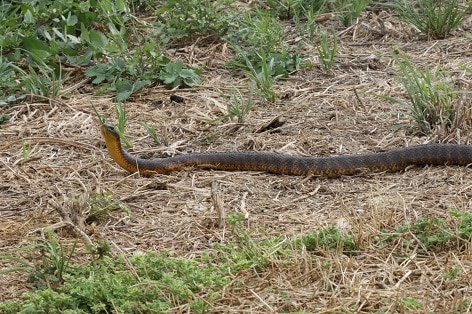
Maximum length: at least 200cm.
The 2nd most prevalent cause of Australian snakebites, at 17% between 2005 and 2015. Tiger snakes are easily identifiable by their bands, and live in southern Australia, both west and east – you won’t find any in the parched northern territories. This venomous snake prefers wet habitats, such as creeks, lagoons, wetlands, swamps and dams. They like to hide under deep, matted vegetation and fallen timber, but will sometimes climb trees.
Tiger snakes don’t hate humans, but they certainly don’t care about them. This species has at least 6 different neurotoxins, plus haemorrhagins, myotoxins, and coagulants. A bite begins with tingling, numbness and sweating, and up to 50% of untreated bites are fatal.
Tiger snakes are unpredictable, as they’ll sometimes flee, but other times stand their ground. A cornered tiger snake will hiss loudly while inflating and deflating its body. This is not a bluff – tiger snakes mean what they say. At 0.12mg, the tiger snake has the third most potent venom of our list, and the venom yield can reach great heights, ranging from 35 to 189mg.
The worst news? Killing one incurs a fine of AU$7500, and a jail sentence of 18 months.
